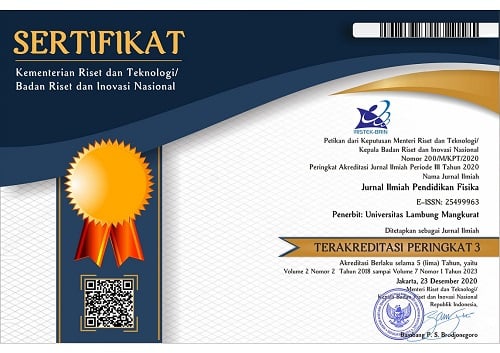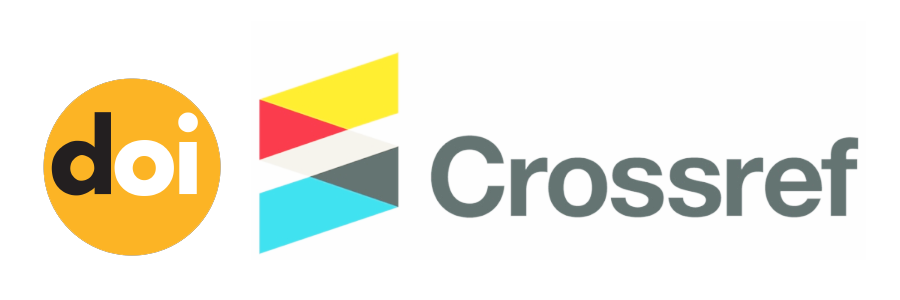The Effect of Using Animation Media on Students' Physics Learning Outcomes in Linear Motion Material
Abstract
This quasi-experimental research was conducted with the aim of 1) comparing the learning outcomes of students taught conventionally and those taught using animation media and 2) calculating the value of the influence of using animation media on student learning outcomes. The experimental research design used in this research is in the form of a nonequivalent control group design with a test as the research instrument, carried out at the research's beginning (pretest) and end (posttest). The sample classes in this study are two classes that were taken using the cluster random sampling method. The results obtained are: 1) The average physics learning outcomes of students in the experimental class are higher than the average learning outcomes in the control class, and 2) There is a significant difference in learning outcome scores between classes that have been taught using animation media compared to conventional classes so that animation media has an influence on students' physics learning outcomes in Pinrang. The research becomes a reference for physics teachers in Pinrang who use animation media in the learning process.
Keywords
Full Text:
PDFReferences
Abdullah, S. I. S. S., Halim, L., & Shahali, E. H. M. (2011). Integration of environmental knowledge across biology, physics and chemistry subject at secondary school level in malaysia. Procedia - Social and Behavioral Sciences, 15, 1024–1028. https://doi.org/10.1016/j.sbspro.2011.03.233
Abdulrahaman, M. D., Faruk, N., Oloyede, A. A., Surajudeen-Bakinde, N. T., Olawoyin, L. A., Mejabi, O. V., Imam-Fulani, Y. O., Fahm, A. O., & Azeez, A. L. (2020). Multimedia tools in the teaching and learning processes: A systematic review. Heliyon, 6(11), e05312. https://doi.org/10.1016/j.heliyon.2020.e05312
Agustianti, R., Nussifera, L., Angelianawati, L., Meliana, I., Sidik, E. A., Nurlaila, Q., ... & Hardika, I. R. (2022). Metode penelitian kuantitatif dan kualitatif. Tohar Media.
Ambe, B. A., Agbor, C. E., Amalu, M. N., Ngban, A. N., Bekomson, A. N., Etan, M. O., Ephraim, I. E., Asuquo, E. E., Eyo, O. E., & Ogunjimi, J. O. (2024). Electronic media learning technologies and environmental education pedagogy in tertiary institutions in nigeria. Social Sciences and Humanities Open, 9(May 2023), 100760. https://doi.org/10.1016/j.ssaho.2023.100760
Anggraeni, R. D., & Kustijono, R. (2013). Pengembangan media animasi fisika pada materi cahaya dengan aplikasi flash berbasis android. Jurnal Pendidikan Fisika Dan Aplikasinya (JPFA), 3(1). http://blogandroidx86.blogspot.co
Cotič, N., Plazar, J., Starčič, A. I., & Zuljan, D. (2020). The effect of outdoor lessons in natural sciences on students’ knowledge, through tablets and experiential learning. Journal of Baltic Science Education, 19(5), 747–763. https://doi.org/10.33225/jbse/20.19.747
Degner, M., Moser, S., & Lewalter, D. (2022). Digital media in institutional informal learning places: A systematic literature review. Computers and Education Open, 3(December 2021), 100068. https://doi.org/10.1016/j.caeo.2021.100068
Fakhri, M. I., Bektiarso, S., & Supeno, S. (2018). Penggunaan media pembelajaran animasi berbantuan macromedia flash pada pembelajaran fisika pokok bahasan momentum, impuls, dan tumbukan kelas x sma. Jurnal Pembelajaran Fisika, 7(3), 271-277.
Fandos-Herrera, C., Jiménez-Martínez, J., Orús, C., Pérez-Rueda, A., & Pina, J. M. (2023). The influence of personality on learning outcomes and attitudes: The case of discussants in the classroom. International Journal of Management Education, 21(1). https://doi.org/10.1016/j.ijme.2022.100754
Febri Sudarma, T. (2016). Perancangan media pembelajaran fisika berbasis animasi komputer pada mata kuliah fisika sekolah. Jurnal Ikatan Alumni Fisika Universitas Negeri Medan, 2(4). https://data.undp.org/dataset/Table-8-
Jaafar, F., Ramli, W. N. R. W., & Fauzi, F. H. A. (2013). Integration of claymation technology as a learning media for preschool studies. Procedia - Social and Behavioral Sciences, 105, 352–359. https://doi.org/10.1016/j.sbspro.2013.11.037
Johari, A. H., & Muslim, M. (2018). Application of experiential learning model using simple physical kit to increase attitude toward physics student senior high school in fluid. Journal of Physics: Conference Series, 1013(1). https://doi.org/10.1088/1742-6596/1013/1/012032
John, A., & Bates, S. (2024). Social and emotional learning : Research , practice , and policy barriers and facilitators : The contrasting roles of media and technology in social – emotional learning. Social and Emotional Learning: Research, Practice, and Policy, 3(August 2023), 100022. https://doi.org/10.1016/j.sel.2023.100022
Lehesvuori, S., Lehtinen, A., Hämäläinen, R., Maunuksela, J., & Koskinen, P. (2023). Student-centredness in physics laboratory teaching sessions. Learning, Culture and Social Interaction, 43(October). https://doi.org/10.1016/j.lcsi.2023.100773
Ma’ruf, M., & Lestari, R. A. (2019). Profil tingkat pemahaman konsep fisika gerak lurus dengan model conceptual understandin procedures. Jotalp: Journal of Teaching and Learning Physics, 4(2), 18–24.
Nasir, M. (2011). Motivasi dan minat belajar fisika siswa dengan menggunakan pemrograman interaktif animasi dan visualisasi gerak dan analisis vektor di sma negeri pekanbaru. In Seminar Pendidikan Serantau, 147.
Nurhayati, F. S. M. (2014). Penerapan metode demonstrasi berbantu media animasi software phet terhadap hasil belajar siswa dalam materi listrik dinamis kelas x madrasah aliyah negeri 1 pontianak. Jurnal Pendidikan Fisika Dan Aplikasinya (JPFA), 4(2).
Permana, I., & Kadir, F. (2018). Efektivitas pembelajaran dengan
menggunakan media animasi terhadap pemahaman konsep fisika siswa kelas x sman 3 pinrang. Karst: Jurnal Pendidikan Fisika dan Terapannya, 3(2) 46-53
Qurbaniah, M., Setiadi, A. E., & Kurniawan, D. (2023). The effectiveness of animated videos on high-level thinking skills of sma negeri 1 silat hulu students. Journal of Biology Education. 6(2) 149-162.
Ramadhan, G., Rohana, R., & Pada, A. (2023). The effect of use animation media on learning outcomes in science learning of the fourth grade students telkom makassar. International Journal of Elementary School Teacher, 1(2), 175. https://doi.org/10.26858/ijest.v1i2.17970
Said, S., Nurnaifah, I. I., & Muh. Saleh, S. (2023). Upaya peningkatan motivasi belajar fisika melalui pemberian reward peserta didik smkn 3 pinrang pasca covid. Al-Irsyad Journal of Physics Education, 2(2), 94–104. https://doi.org/10.58917/ijpe.v2i2.75
Sakti, I. (2013). Pengaruh media animasi fisika dalam model pembelajaran langsung (direct instruction) terhadap minat belajar dan pemahaman konsep fisika siswa di sma negeri kota bengkulu. Optical Properties of Photonic Crystals, 2(9).
Sani, N. K., Satria, S., & Pendit, D. (2020). Peningkatan hasil belajar fisika melalui model pembelajaran kooperatif tipe jigsaw berbantuan animasi komputer pada siswa kelas viiia smp negeri 19 palu. Jurnal Kreatif Online, 8(3).
Schneider, S., Krieglstein, F., Beege, M., & Rey, G. D. (2023). Successful learning with whiteboard animations – a question of their procedural character or narrative embedding? Heliyon, 9(2), e13229. https://doi.org/10.1016/j.heliyon.2023.e13229
Sukiyasa, S., Kadek, K., & Sukoco, S. (2013). Pengaruh media animasi terhadap hasil belajar dan motivasi belajar siswa materi sistem kelistrikan otomotif. Jurnal Pendidikan Vokasi. 3(1) 126-137.
Suri, P. A., Syahputra, M. E., Amany, A. S. H., & Djafar, A. (2022). Systematic literature review: The use of virtual reality as a learning media. Procedia Computer Science, 216(2022), 245–251. https://doi.org/10.1016/j.procs.2022.12.133
Sutiani, A., & Silitonga, M. Y. (2017). The effect of learning models and emotional intelligence toward students learning outcomes on reaction rate. AIP Conference Proceedings, 1868. https://doi.org/10.1063/1.4995110
White, H., & Sabarwal, S. (2014). Quasi-experimental design and methods. Methodological briefs: impact evaluation, 8(2014), 1-16.
DOI: https://doi.org/10.20527/jipf.v8i1.11530
Refbacks
- There are currently no refbacks.
Indexed by: Jurnal Ilmiah Pendidikan Fisika is licensed under a creative commons attribution-share alike 4.0 international license
Statistics Counter |
















